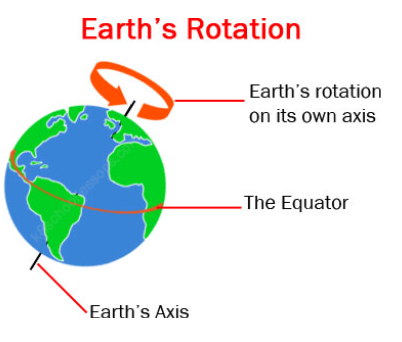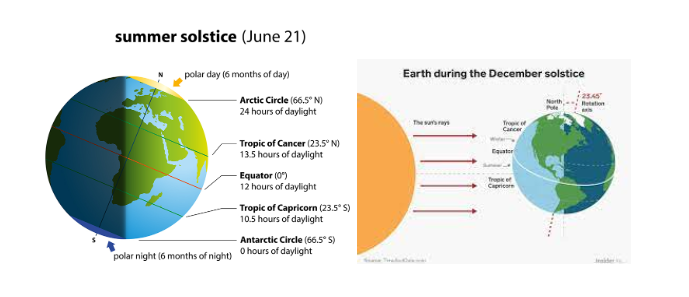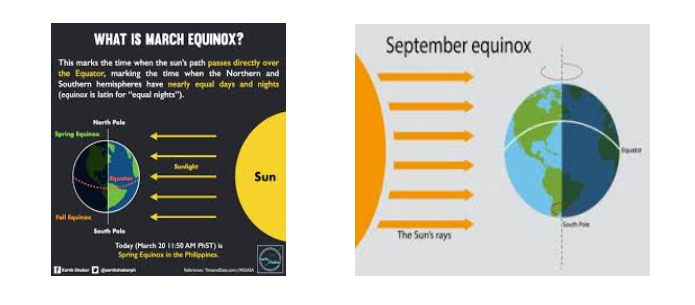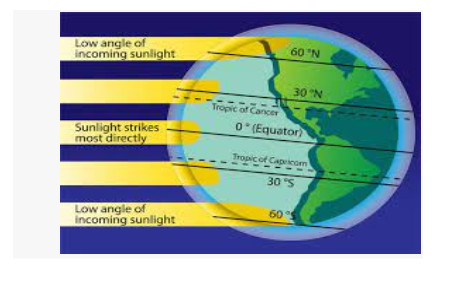Motions Of the Earth - Inclination of the Earth’s Axis and its Effects
Earth has primarily two motions
1-ROTATION OF EARTH
- The Earth indeed rotates on its axis from west to east, and it takes approximately 24 hours to complete one full rotation.
- This rotation is the reason we experience alternating days and nights, as different parts of the Earth are exposed to sunlight or in shadow at different times.
- The line that separates day from night on the globe is known as the circle of illumination.
- Crucially, the Earth's axis is tilted, making an angle of 23.5 degrees with the perpendicular (which means it's inclined by 66.5 degrees to the plane of the Earth's orbit around the Sun). This axial tilt is responsible for the changing seasons and variations in daylight hours throughout the year.

REVOLUTION
- The Earth's movement around the Sun in its orbit is known as revolution. It completes one full revolution in 365¼ days, which we consider as one year.
- To account for the additional six hours that accumulate each year due to the not-quite-perfect 365.25-day cycle, we add these extra hours over a span of four years, creating an additional full day (24 hours).
- This extra day is added to the month of February. Therefore, every fourth year, February has 29 days instead of the usual 28 days. This year with 366 days is called a leap year. Leap years help us align our calendar with the Earth's orbital motion more accurately.

SOLASTICE
- On the 21st of June, the northern hemisphere leans toward the Sun, causing its rays to shine directly on the Tropic of Cancer. This results in these areas receiving more warmth, ushering in the summer season.
- Conversely, regions closer to the poles get less heat because the Sun's rays come in at an angle. Beyond the Arctic Circle, places experience continuous daylight for approximately six months due to the North Pole tilting toward the Sun.
- In the regions north of the equator, where a significant part of the northern hemisphere is bathed in sunlight, it becomes summer, marked by the longest day and the shortest night on the 21st of June. This event is known as the summer solstice.
- On December 22nd, the Tropic of Capricorn is directly illuminated as the South Pole tilts toward it. The Sun's rays fall vertically at the Tropic of Capricorn (23½° south), allowing a larger portion of the southern hemisphere to receive light.
- Consequently, the southern hemisphere experiences summer with longer days and shorter nights, while the northern hemisphere encounters the reverse, with shorter days and longer nights. This is termed the winter solstice.

EQUINOX
- On March 21st and September 23rd, the Sun's direct rays hit the equator. During this time, neither of the Earth's poles is tilted toward the Sun. As a result, the entire planet experiences an equal amount of daytime and nighttime. This is known as an equinox.
- On September 23rd, it's autumn in the northern hemisphere (the season after summer and before winter) and spring in the southern hemisphere (the season after winter and before summer). The opposite happens on March 21st, when it's spring in the northern hemisphere and autumn in the southern hemisphere.
- So, we have days and nights because of the Earth's rotation, and we experience changes in the seasons due to the Earth's revolution around the Sun. Rotation gives us days and nights, while revolution brings us seasons.

REGIONS BEYOND ARCTIC CIRCLE RECEIVE SUNLIGHT ALL DAY LONG IN SUMMER SEASON
This happens because of the way the Earth is tilted. During the summer, the top part of the Earth, near the North Pole, tilts toward the Sun. That's why during the summer, the entire Arctic region is in the "zone of illumination" and enjoys daylight all day long.

Frequently Asked Questions (FAQs) about Earth's Motions and Seasons
1. What is Earth's rotation?
Earth rotates on its axis from west to east.
It takes approximately 24 hours for one full rotation.
2. How does Earth's rotation affect day and night?
Earth's rotation causes day and night as different parts of the Earth receive sunlight at different times.
3. What is the circle of illumination?
The circle of illumination is the line that separates day from night on the globe.
4. Why do we have changing seasons on Earth?
Earth's axis is tilted at an angle of 23.5 degrees, which causes the changing seasons as Earth orbits the Sun.
5. What is Earth's revolution?
Earth's movement around the Sun in its orbit is called revolution.
It completes one revolution in approximately 365¼ days, which we consider one year.
6. Why do we have leap years?
To account for the extra six hours in a year, we add them up over four years to create an extra day.
This extra day is added to February every fourth year, creating a leap year with 366 days to align our calendar with Earth's orbital motion.
7. What is the summer solstice?
On June 21st, the northern hemisphere tilts toward the Sun, resulting in more warmth and the start of summer.
It marks the longest day and the shortest night in the northern hemisphere.
8. What is the winter solstice?
On December 22nd, the southern hemisphere is tilted toward the Sun, bringing summer to that part of the world.
The northern hemisphere experiences the opposite, with shorter days and longer nights.
9. What is an equinox?
Equinoxes occur on March 21st and September 23rd.
On these days, the Sun's direct rays hit the equator, and the whole Earth experiences an equal amount of daytime and nighttime.
10. How do equinoxes affect the seasons?
On September 23rd, it's the start of autumn in the northern hemisphere and the beginning of spring in the southern hemisphere.
On March 21st, it's spring in the northern hemisphere and autumn in the southern hemisphere.
11. Why do regions beyond the Arctic Circle receive daylight all day long in summer?
During the summer, the North Pole tilts toward the Sun, causing the entire Arctic region to be in the "zone of illumination," resulting in continuous daylight.


